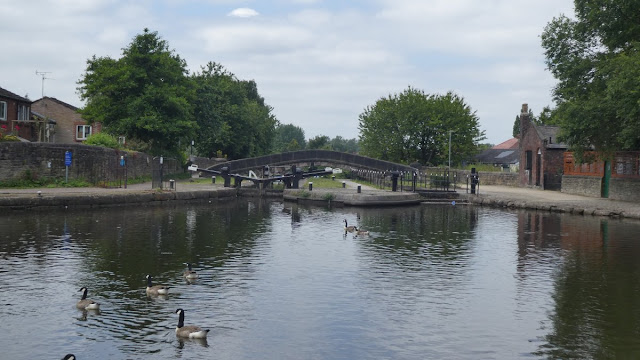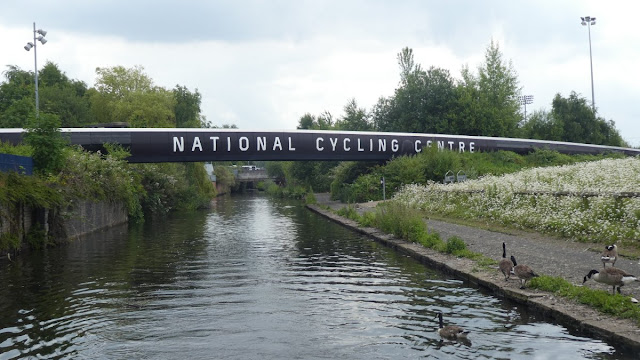This posting covers our experience on the Peak Forest Canal. This runs from Bugsworth and Whaley Bridge to Dukinfield Junction where it meets both the Ashton and the Huddersfield Narrow Canals. In the middle lie the Marple Locks, a flight of 16 leading down to the valley of the River Goyt. The Peak Forest has some spectacular scenery and its upper section lies part way up the side of the Goyt valley with views towards Kinder Scout and the other hills of the Peak District.
So here is the account of our journey on this canal. At Marple Junction where the Macclesfield meets the Peak Forest we turned right for 7 miles to the terminus at Bugsworth Basin. We then turned round and retraced our steps to reach the Marple Locks and beyond.
 |
In the 7 miles between Marple and Bugsworth there are four lift or swing bridges, only one of which is power assisted. This one is Turf Lea Lift Bridge which is Helen powered by turning a windlass umpteen times to lift the bridge.
|
 |
And this is Higgins Clough Swing Bridge which is also Helen powered using a lever to open the bridge.
|
 |
Near the end of the canal a short branch goes south to Whaley Bridge. A horse tunnel beneath the canal shown here allowed horses to leave the main canal and follow the Whaley Bridge branch. You may remember that Whaley Bridge was nearly inundated a couple of years ago by a failure of the dam of the Toddbrook reservoir. The reservoir has yet to be filled with water after the necessary repair.
|
 |
Bugsworth Basin was built as a transhipment place for limestone and other materials brought down from the hills on horse-drawn tramways. It has a number of arms and the pictures shows Leo moored in the Upper Basin.
|
 |
To the left here is the lower basin with channel to the right leading to the middle and upper basins. It is a super spot and we stayed there for a few days.
|
 |
Last Thursday from Bugsworth we did a 10 mile hike in the hills towards Edale. The original intention was to get the train to Edale and walk back but the train we needed was cancelled. The picture shows Cracken Edge above the village of Chinley. This has numerous old quarries along the line of the rocky cliffs shown.
|
 |
Having walked the length of the Edge, we dropped down and then climbed South Head closer to Kinder. Cracken Edge can be seen now in the distance.
|
 |
This lamb was keeping a close eye on the activities of the humans.
|
 |
The cairn marks the top of South Head and the picture is taken looking north west towards Manchester which we could see in the distance.
|
 |
The edge of the Kinder Scout plateau could be clearly seen from South Head. The plateau is at around 2,000 feet above sea level and we were about 1,650.
|
 |
These adolescent male Highland cattle eyed us with interest as we found our way back to Bugsworth.
|
 |
Having left Bugsworth on Leo we moored for the night on Saturday close to the top of the Marple locks and high above the Goyt valley. An interesting walk took us down to the river and along it to Mellor Mill of which the photo shows the excavated remains after it was demolished by fire. The cotton mill was the largest in the world when it was built in the 1790s. It was originally powered by water and later by steam engine.
|
 |
This view gives an idea of the outlook from the Peak Forest Canal. Wonderful.
|
 |
As we came back down a hill towards our mooring this was the view which we think is looking back towards the high hills around Bugsworth.
|
 |
On Sunday we descended the 16 Marple locks. In this view as we approached the top lock, the Macclesfield Canal comes in under the bridge and the locks lie to the right.
|
 |
The Marple Locks are really deep as this shot shows. The flight drops 214 feet in 16 locks, so an average of 13 feet 4 inches each! Some are even deeper than this.
|
 |
Here we are looking back towards the top lock from the second one down. The residential road to the right follows the lock flight down the steep hill.
|
 |
Between locks 13 and 12 (they are numbered from the bottom) the canal passes under a road and to the right you can see another example of a horse tunnel.
|
 |
The large stones used to build the locks sometimes, as here, have characteristic marks made by the stonemasons who each had their own mark.
|
 |
This warehouse was built in the early 1800s by Samuel Oldknow who also built the Mellor Mill already mentioned.
|
 |
Lock 7 was substantially rebuilt over last winter and was only reopened about 10 days before we used it. As you can see quite a lot of new stone was used in the rebuilding.
|
 |
Here we are approaching the bottom lock of the flight. The chap in the blue is a CRT person who helped us down the flight by setting each lock ahead of us. As a result partly of his help we got down the 16 locks in a little over 2 hours!
|
 |
Below the locks the canal crosses the River Goyt by means of an aqueduct about 100 feet above the river. The view down is quite vertiginous.
|
 |
Here is Leo on the aqueduct and alongside is a railway viaduct. For those of you who have our 'business card' this is the view on the card, not the more famous and very similar aqueduct at Chirk on the Llangollen Canal. The railings have been added since we last came this way. Before then you could step off your boat on that side with no protection from the 100 foot drop.
|
 |
Soon after the aqueduct the canal becomes much more wooded and has deep cuttings and a couple of tunnels as it crosses from the Goyt valley to the valley of the River Tame. This photo is looking back to Woodley tunnel. It is only 167 yards long and you can see the far end in the picture. Unusually this tunnel has the towpath continuing through it. More commonly the towpath goes over the top. Experienced horses often knew the route and would cross to the other side on their own.
|
 |
This picture was taken close to the end of the Peak Forest Canal at Dukinfield Junction. Leo at this point is on an aqueduct over the River Tame. Another mill chimney dominates the picture.
|
 |
Just the other side of this bridge is the junction with the Huddersfield Narrow canal to the right and the Ashton Canal to the left. The Huddersfield Narrow crosses the Pennines to reach its named city while the Ashton Canal, which we took, leads to Manchester.
|
 |
Here is the sign at the junction.
|
Our next posting will cover our experience of the Ashton Canal which is only 6 miles long but has another 18 locks to descend to Manchester. The next posting will be pretty soon as we are now (Tuesday evening) moored close to the end of the Ashton.


























































